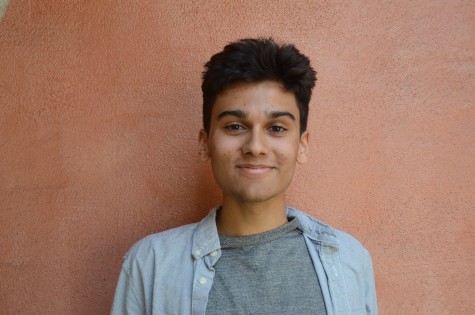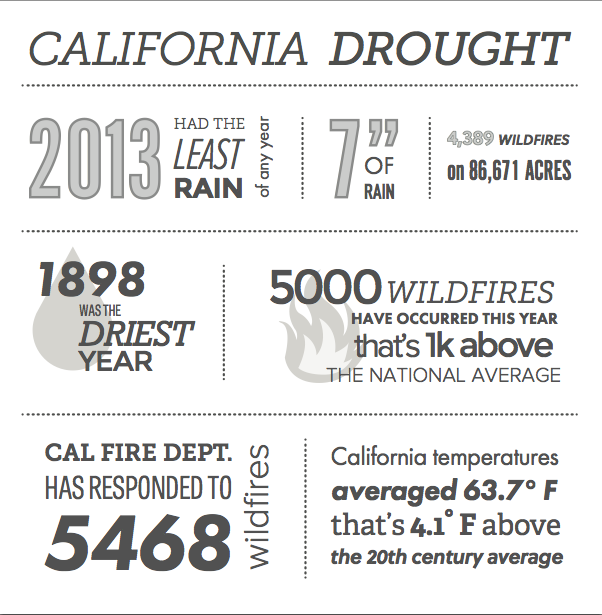California remains in state of exceptional drought
Despite recent rain, 55 percent of California remains in a state of exceptional drought, according to the U.S. Drought Monitor.
“This rainfall will have minimal effect on California’s drought conditions, and reservoir water levels will remain largely unchanged,” an Oct. 27 brief from the California Drought Information Clearinghouse said. “Due to low water supplies from the two previous dry years, California remains in drought conditions.”
California’s drought has caused increases in wildfires, more than 1,000 over the average this year. It has also drained reservoirs: according to the California Data Exchange Center, the overall water stored in reservoirs has dropped to less than half of the average.
On Jan. 17, Governor Jerry Brown called a state of emergency for the drought, according to his website.
Some students have remained aware of the severity of the drought.
“It’s still going on and it’s still a problem, but since the recent rains, I think people have forgotten about it,” Lev Sepetov (11) said. “They should still think about it.”
Other students are more optimistic.
“It’s gotten better,” Nate Kelly (9) said. “I feel like it’s going to rain a lot in December.”
Winter rain may help alleviate the drought, but will not end it, according to the Oct. 27 brief. California Department of Water Resources Information Officer Lauren Bisnett also commented on rainfall prospects.
“We’re hoping that we’re going to get a lot of rainfall […] but there’s no guarantees for that, especially with the role the climate change plays in how we’re seeing less and less rain each year,” Bisnett said.
Bisnett also emphasized the importance of reducing water use.
“You need to be conserving all the time […] even in those years when we’re not in a drought,” she said.
Q&A with Lauren Bisnett
Information Officer, California Department of Water Resources
Winged Post: Should Californians be more or less concerned about the drought now than this past summer?
Lauren Bisnett: Californians always need to be concerned about the drought, no matter what time of year it is. And I say that sort of twofold. So one, what we’re really doing is we can’t bank on expecting a lot of rainfall. We’re hoping that we’re going to get a lot of rainfall with the snowpack, one third of our water supply. We’ll see good precipitation this coming winter season, but there’s no guarantees for that, especially with the role the climate change plays in how we’re seeing less and less rain each year, and that means a diminishing snowpack. So we’re certainly taking actions now to be prepared for another dry year, but we’re also hoping for rain and hoping for the best. And then in the bigger picture scheme of things, whether we’re in a drought or not, all Californians really need to be planning for those years that we’re not in drought. So that means being good environmental stewards and taking care of our groundwater supply, making good investments in infrastructure so that we have good water storage in our reservoirs, perhaps new reservoirs, and so really. it’s about looking at the near term, but also the long term, so the years when we’re not in a drought, we’re prepared for when we do go into a drought.
WP: What have been the most severe effects of the drought so far?
LB: I would say the most severe effect [that] you can imagine is health and human safety, obviously, and also major impacts to the environment. So in years such as drought you see we’re more prone to wildfires taking place. So that takes an enormous toll on the environment and on people. Since we’re going into our third dry year of drought […] we definitely have seen significant impact to people’s drinking water supplies, which is water in their homes. So we’ve seen numerous impacts, and those are just a couple to name off the top. So it just depends too on where you are in California in terms of how severe the drought impact is going to be on you because some people rely on groundwater supplies which are being heavily depleted this year, whereas other parts of the state, maybe more up north, [have] more precipitation and are less reliant on groundwater, but that is also the interesting thing about what we’re finding about this particular drought compared to the drought that took place in the late 1920s and the drought that took place in the late 70s is that the conditions are most definitely drier or reaching those record dry, and so we expect that […] any impact we see now […] can be compounded going into another dry year. So just again, huge impacts on birds and fish and wildlife, you probably saw the wildfires throughout the state […] the impacts are all over the state. It just depends on where you are because we are such a diverse state in terms of the impact you’re going to see.
WP: Do you feel that there is any droughtrelated issue that the public is not sufficiently aware of?
LB: I think the biggest thing the real message out to all Californians, the one we can’t really spread enough awareness of, is conservation. You need to be conserving all the time, and again, even in those years when we’re not in a drought. And so that means educating children as they’re getting older and becoming responsible community members and citizens and just conserving water at home, and conserving water when you’re in your backyard and considering using maybe drought tolerant plants and native plants. Things like turning off the water when you brush your teeth, taking ten minute showers, doing full loads of laundry, these are all practical ways that Californians can save water that add up to huge saving across the state. And what that means is it makes our water resources more sustainable for the entire population. So the major thing is just to be conscious of drought whether we’re in a drought or not and people should be aware that there are hazards. We can be in a drought, for example, and still some areas of the state can be susceptible to flash floods. For example, there’s a heavy rain in 1 particular area that’s been dry. There are problems that can be caused with that, and so the big message is just for Californians to be prepared and to always be conserving water.
An abridged version of this piece was originally published in the pages of The Winged Post on November 21, 2014.

Praveen Batra (9) is a reporter for the Winged Post. He enjoys informative writing, design, and typography. In his spare time, he likes to write mobile...

Shay Lari-Hosain (12) is the Editor-in-Chief and co-founder of Wingspan Magazine. Shay has interviewed 2013 Nobel Laureates, authors like Khaled Hosseini...


















![“[Building nerf blasters] became this outlet of creativity for me that hasn't been matched by anything else. The process [of] making a build complete to your desire is such a painstakingly difficult process, but I've had to learn from [the skills needed from] soldering to proper painting. There's so many different options for everything, if you think about it, it exists. The best part is [that] if it doesn't exist, you can build it yourself," Ishaan Parate said.](https://harkeraquila.com/wp-content/uploads/2022/08/DSC_8149-900x604.jpg)




![“When I came into high school, I was ready to be a follower. But DECA was a game changer for me. It helped me overcome my fear of public speaking, and it's played such a major role in who I've become today. To be able to successfully lead a chapter of 150 students, an officer team and be one of the upperclassmen I once really admired is something I'm [really] proud of,” Anvitha Tummala ('21) said.](https://harkeraquila.com/wp-content/uploads/2021/07/Screen-Shot-2021-07-25-at-9.50.05-AM-900x594.png)







![“I think getting up in the morning and having a sense of purpose [is exciting]. I think without a certain amount of drive, life is kind of obsolete and mundane, and I think having that every single day is what makes each day unique and kind of makes life exciting,” Neymika Jain (12) said.](https://harkeraquila.com/wp-content/uploads/2017/06/Screen-Shot-2017-06-03-at-4.54.16-PM.png)








![“My slogan is ‘slow feet, don’t eat, and I’m hungry.’ You need to run fast to get where you are–you aren't going to get those championships if you aren't fast,” Angel Cervantes (12) said. “I want to do well in school on my tests and in track and win championships for my team. I live by that, [and] I can do that anywhere: in the classroom or on the field.”](https://harkeraquila.com/wp-content/uploads/2018/06/DSC5146-900x601.jpg)
![“[Volleyball has] taught me how to fall correctly, and another thing it taught is that you don’t have to be the best at something to be good at it. If you just hit the ball in a smart way, then it still scores points and you’re good at it. You could be a background player and still make a much bigger impact on the team than you would think,” Anya Gert (’20) said.](https://harkeraquila.com/wp-content/uploads/2020/06/AnnaGert_JinTuan_HoHPhotoEdited-600x900.jpeg)

![“I'm not nearly there yet, but [my confidence has] definitely been getting better since I was pretty shy and timid coming into Harker my freshman year. I know that there's a lot of people that are really confident in what they do, and I really admire them. Everyone's so driven and that has really pushed me to kind of try to find my own place in high school and be more confident,” Alyssa Huang (’20) said.](https://harkeraquila.com/wp-content/uploads/2020/06/AlyssaHuang_EmilyChen_HoHPhoto-900x749.jpeg)



